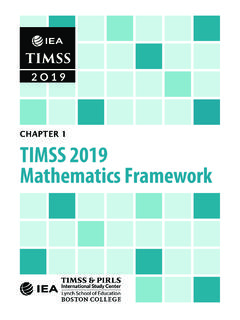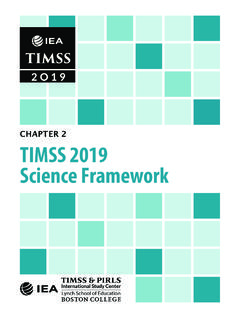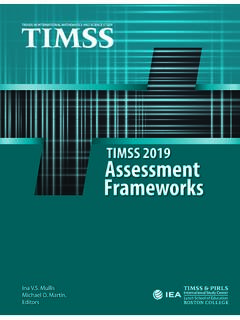Transcription of CHAPTER 3 TIMSS 2019 Context Questionnaire Framework
1 CHAPTER 3. TIMSS 2019 . Context Questionnaire Framework TIMSS & PIRLS. International Study Center Lynch School of Education CHAPTER 3. TIMSS 2019 Context Questionnaire Framework Martin Hooper Ina Mullis Michael O. Martin Bethany Fishbein At both the fourth and eighth grades, students participating in TIMSS complete questionnaires about their experiences, instruction, and attitudes toward learning mathematics and science. Their teachers and school principals complete questionnaires to provide data about school and classroom resources and approaches, and parents of fourth graders fill out a Questionnaire about students' home contexts for learning.
2 To better understand national contexts and policies, representatives from each participating country complete a curriculum Questionnaire and contribute a CHAPTER to the TIMSS 2019 Encyclopedia. Students taking TIMSS using a computer or tablet also fill out a short Questionnaire about their experiences with computers and the Internet. The TIMSS questionnaires have undergone a process of evolution and development since TIMSS . was first administered in 1995, a process that continually sought to improve the quality and relevance of the data while keeping the response burden on principals, teachers, students, and parents to a minimum.
3 In each four year assessment cycle, the Questionnaire development team at the TIMSS &. PIRLS International Study Center worked with the TIMSS Questionnaire Item Review Committee (QIRC) to review the questionnaires and suggest ways to update them including adding new topics, refining individual questions, and deleting questions or topics that are no longer useful. The TIMSS 2019 Context Questionnaire Framework describes those aspects of the learning Context to be addressed by the TIMSS 2019 questionnaires, together with a rationale for why they should be included and research literature references as appropriate.
4 As a study of trends in student achievement and mathematics, TIMSS ' first priority in characterizing the educational Context is to gather data on policy relevant and malleable attributes of the home and school that can help interpret achievement changes from assessment to assessment. Where possible, such contextual data are summarized as Context Questionnaire scales that are used to measure changes from one assessment to the next. Relating changes in student achievement to changes in educational policies or practice can be a powerful source of evidence that the policy or practice is beneficial for student learning.
5 TIMSS & PIRLS. International Study Center Lynch School of Education TIMSS 2019 Context Questionnaire Framework 59. For example, TIMSS 2015 reported differences from TIMSS 2011 on a number of background scales such as the Early Literacy and Numeracy Activities scale and the Students Like Learning Mathematics scale. TIMSS 2019 plans to improve and expand trend measurement using these and other scales. The TIMSS 2019 Context Questionnaires have the dual purpose of linking to the past and building a bridge to the future. The world is changing in important ways, and so are educational policies and practices around the world.
6 It is important for the TIMSS 2019 Context Questionnaires to reflect these changes. This will be managed by updating aspects of existing scales to reflect new and improved understandings of the constructs being measured, and also by including new scales about important aspects of educational effectiveness. The Framework also includes other topics that are important to TIMSS participating countries and education researchers but have not been shown to be related to achievement on the TIMSS assessment. These topics are generally considered to be important aspects of the education systems and beneficial for student learning, and TIMSS plays a key role in collecting data on these topics in the international Context .
7 For example, through the curriculum Questionnaire and TIMSS Encyclopedia, TIMSS plays an important role in documenting international trends in curricular policy and other educational policies. However, many country level policies do not show a direct relationship with TIMSS achievement. The remainder of this CHAPTER details the topics to be covered in the TIMSS 2019 Context questionnaires. The CHAPTER is structured to focus on five broad areas: Community and national policies Home contexts School contexts Classroom contexts Student attitudes toward learning Community and National Policies Countries, regions, and communities make key educational policy decisions about the curriculum and how it is best implemented.
8 Primarily through the TIMSS Encyclopedia and curriculum questionnaires, TIMSS 2019 will cover five broad national and community policies: Intended mathematics and science curriculum Language(s) of instruction Student flow Teacher education Principal certification TIMSS & PIRLS. International Study Center Lynch School of Education TIMSS 2019 Context Questionnaire Framework 60. Intended Mathematics and Science Curriculum Since 1995, TIMSS has collected extensive data on the content of the intended curriculum. Whether formulated at the national, community, or school level, curricular documents define and communicate the curriculum, providing expectations for students in terms of the knowledge, skills, and attitudes to be developed or acquired through their formal mathematics and science education.
9 Internationally, mathematics and science curricula differ across countries and are constantly evolving. In mathematics, countries differ in the degree of emphasis they place on acquiring basic skills, memorizing rules, procedures, or facts, understanding mathematical concepts, applying mathematics to real life situations, communicating or reasoning mathematically, and problem solving in everyday situations. In science, countries vary in the extent that they focus on acquiring basic science facts, understanding and applying science concepts, formulating hypotheses, designing and conducting investigations to test hypotheses, using inquiry-based learning, and communicating scientific explanations.
10 Differences in the structure of the science curriculum can result in different experiences for students in different countries. By the eighth grade, some countries teach science as separate subjects (biology, chemistry, physics, and earth science), and others teach it as one integrated subject. Continuing previous practices, countries will provide summaries of their fourth and eighth grade mathematics and science curricula in the TIMSS 2019 Encyclopedia and answer questions about their curricula in the curriculum Questionnaire . Collecting data on curricular content over time can provide insights into the evolution of national curricula.


